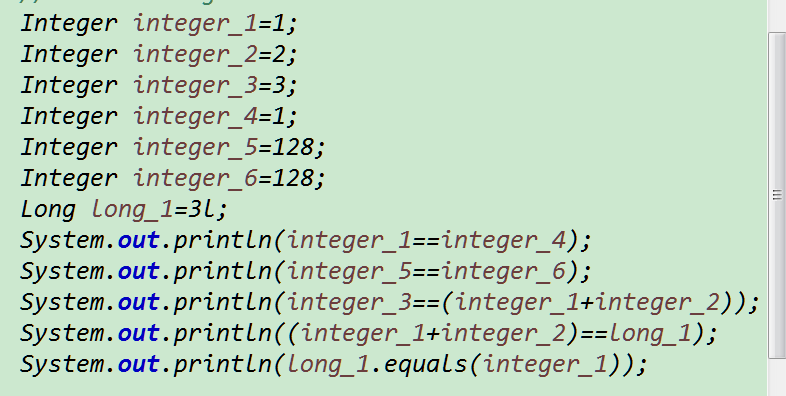JAVA——装箱和拆箱
2016-05-22 23:01
357 查看
Java 将某些基本数据类型自动转换为包装类型的过程称为装箱,相反自动将包装类型转换为基本数据类型的过程称为拆箱。
Integer integer_1=1; //装箱
int i=integer_1; //拆箱
装箱会调用 Integer.valueOf(int) 函数:
拆箱会调用 Integer.intValue(Integer) 函数
几个面试中会经常遇到的问题:
先来看一段代码:

这段代码的输出结果是:

对于第一行和第二行,因为装箱会调用valueOf(),我们来看看这个函数的源码:
IntegerCach的源码是:
从源码可以看出来这个函数内部是怎么处理装箱的,如果这个int值在-128-127之间,会返回一个已经定义好了的数组里面的元素,所以第一行是 true ,第二行是 false。
这里需要注意的是:除开浮点型的数值,Double和Float,其余的类型(当然包括Boolean类型)均是类似的操作,因为Double和Float的数值个数是无法统计的。如下:
可能开始你会想结果是true,其实结果是false:
对于第三行,和第四行,如果==有一边存在算术表达式,则会拆箱,所以第3,4行均为true。
对于第5行,equals函数不会改变对象类型,所以类型不一样们自然是false。
另一个问题:
Integer i=new Integer(1); 和 Integer i=1又和区别?
前者不会触发装箱,后者会触发装箱,性能上和执行效率上,后者一般更优,但不是绝对的。
Integer integer_1=1; //装箱
int i=integer_1; //拆箱
装箱会调用 Integer.valueOf(int) 函数:
拆箱会调用 Integer.intValue(Integer) 函数
几个面试中会经常遇到的问题:
先来看一段代码:

这段代码的输出结果是:

对于第一行和第二行,因为装箱会调用valueOf(),我们来看看这个函数的源码:
1 public static Integer valueOf(int i) {
2 assert IntegerCache.high >= 127;
3 if (i >= IntegerCache.low && i <= IntegerCache.high)
4 return IntegerCache.cache[i + (-IntegerCache.low)];
5 return new Integer(i);
6 }IntegerCach的源码是:
private static class IntegerCache {
static final int low = -128;
static final int high;
static final Integer cache[];
static {
// high value may be configured by property
int h = 127;
String integerCacheHighPropValue =
sun.misc.VM.getSavedProperty("java.lang.Integer.IntegerCache.high");
if (integerCacheHighPropValue != null) {
int i = parseInt(integerCacheHighPropValue);
i = Math.max(i, 127);
// Maximum array size is Integer.MAX_VALUE
h = Math.min(i, Integer.MAX_VALUE - (-low));
}
high = h;
cache = new Integer[(high - low) + 1];
int j = low;
for(int k = 0; k < cache.length; k++)
cache[k] = new Integer(j++);
}
private IntegerCache() {}
}从源码可以看出来这个函数内部是怎么处理装箱的,如果这个int值在-128-127之间,会返回一个已经定义好了的数组里面的元素,所以第一行是 true ,第二行是 false。
这里需要注意的是:除开浮点型的数值,Double和Float,其余的类型(当然包括Boolean类型)均是类似的操作,因为Double和Float的数值个数是无法统计的。如下:
Double double_1=27.0; Double double_2=27.0; System.out.println(double_1==double_2);
可能开始你会想结果是true,其实结果是false:
对于第三行,和第四行,如果==有一边存在算术表达式,则会拆箱,所以第3,4行均为true。
对于第5行,equals函数不会改变对象类型,所以类型不一样们自然是false。
另一个问题:
Integer i=new Integer(1); 和 Integer i=1又和区别?
前者不会触发装箱,后者会触发装箱,性能上和执行效率上,后者一般更优,但不是绝对的。
相关文章推荐
- Java 枚举7常见种用法
- Java实现将一个文件进行压缩
- spring集成Ehcache
- 设计模式(23种,java)
- Java设计模式(一):单例模式,防止反射和反序列化漏洞
- struts2与ognl结合实现下载
- springMVC传对象参数、返回JSON格式数据
- java适配器设计模式
- Spring控制反制IOC
- Java 鼠标点击事件实例
- 大话设计模式java版--适配器模式-关于不接口设计错误导致的处理方案
- spring的依赖注入
- Spring中Bean的使用
- spring mvc 异常统一处理方式
- 用遗传算法走迷宫 [Java语言实现]
- Java中获取路径的方法
- Java实现复制一个目录下的所有文件
- java之装饰者模式
- java程序使用JDBC接口连接数据库
- Struts 2 的stream result用法
